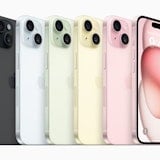 We have high hopes for the mobile world in 2013. If the past few years are any indicator, mobile technology should move forward an impressive amount within the next 12 months. Usually what we’ve seen is a lot of rumor and speculation for the first half of a year followed by an absolute explosion of new devices and services in the months from July to October.
We have high hopes for the mobile world in 2013. If the past few years are any indicator, mobile technology should move forward an impressive amount within the next 12 months. Usually what we’ve seen is a lot of rumor and speculation for the first half of a year followed by an absolute explosion of new devices and services in the months from July to October.
Of course, rumors already abound regarding certain companies and devices, but we’ll try to focus on general improvements and directions, rather than getting caught up in each and every rumor surrounding every potential handset on the market.
Android
 Android has improved in leaps and bounds over the past 24 months. As we’ve mentioned a few times before, where just two years ago many of our friends, family and acquaintences would ask of us “when is the next iPhone coming out?” we are now posited with the questions “what’s the best phone or the market?” or “so what’s the deal with Android, then?”
Android has improved in leaps and bounds over the past 24 months. As we’ve mentioned a few times before, where just two years ago many of our friends, family and acquaintences would ask of us “when is the next iPhone coming out?” we are now posited with the questions “what’s the best phone or the market?” or “so what’s the deal with Android, then?”
This is because the Android operating system (OS) has finally improved to the point where the average user is starting to take notice.
Note: we are not saying that Android hasn’t been good until now, far from it. I personally carry and Android smartphone and currently feel as though I will upgrade to a new one once my plan needs renewing. But Android has not traditionally been a mobile OS that appeals to the masses. This is because of several factors such as a perceived lack of intuitiveness, fragmentation between devices and its tendency to crash or provide a jerky UI experience more often than iOS, among other issues both perceived and real.
Recently many of these factors, with the exclusion of fragmentation, have been either lessened or completely eliminated. Furthermore, Android devices such as the old Samsung Galaxy S or HTC Desire were very similar to their contemporary iPhone models in many respects, whereas the difference between today's Galaxy S3 or the HTC One X and the iPhone 5 are obvious and numerous.
We have no particularly definite expectations as yet for Android in 2013 other than its continued increase in quality and popularity.
In quality we foresee a smoother OS, longer battery life, a move to 2GB of RAM being the standard for high-end models, increased support for 4G LTE and an increased focus on the improvement of cameras. The last point we don’t have any huge evidence to support, other than that it is still an area where the iPhone (and now the Nokia Lumia 920 with its PureView camera) still outstrips Android devices convincingly.
We also think we’ll see more devices with 1080p displays, although we have to admit that we’re perfectly happy with 720p for now, as it’s usually roughly equal to or better than the 326ppi of an iPhone Retina Display.
As far as screen size goes the last two years has seen a significant increase from a standard of between 3.7 and 4 inches to a whopping 4.7 to 4.8 inches in high-end devices. We don’t think this will increase too much further, as anything 5 or above is definitely entering ‘phablet’ country. What we should definitely see is more damage resistant screens, a higher average quality of color and contrast in displays, and an increase in display energy efficiency.
Windows Phone
 2013 is going to be a very big year for Windows Phone. With WP8 having just hit the shelves, 2013 could very much be a make-or-break 12 months for the whole Windows Phone ecosystem.
2013 is going to be a very big year for Windows Phone. With WP8 having just hit the shelves, 2013 could very much be a make-or-break 12 months for the whole Windows Phone ecosystem.
So far what we’ve used of Windows Phone 8 we’ve loved, but then again we felt similarly about WP7 when it came out and it wasn’t hugely successful. We do feel that WP8 is an even more impressive accomplishment than its predecessor and have noticed in our daily lives a larger public awareness of its existence and even its potential as a viable alternative to iOS or Android.
As far as displays go we don’t think we’ll see a huge increase in size, as many are already around the 4.5 to 4.7 inch range. We do expect an overall increase in quality, even if it’s just that of the HTC and Samsung WP8 ranges in order to compete with Nokia’s AMOLED ClearBlack technology.
More powerful processors and an increase in RAM is almost a given, as is the lean toward better cameras that has already begun with Nokia’s PureView camera on the Lumia 920 which our own designer, Pete, found second only to the iPhone 5 in a detailed iPhone 5 vs Nokia Lumia 920 camera review.
We don’t think we’ll see 1080p displays from Windows Phone this year and possibly even no WP9 update. Truthfully, 1080p screens may very well turn out to be nothing more than a marketing boost rather than a noticeable bump in display quality on a screen smaller than 5 inches, but we’re yet to test one for ourselves so we’ll hold off on judgement until we have a bit more experience under our belts. As for a WP9 update, our hunch is that we'll see a few updates to WP8, but nothing so grand as to warrant a full-one successor.
We’ll hopefully see Nokia reduce the size and weight of its premium Lumia devices, as the 920 is quite a bulky handset when considering it has just a 4.5 inch display. We do still love its colorful design, but we have to admit the 820 is a much more manageable device as far as physical interaction goes.
Speaking of WP8 designs, HTC will likely continue to ‘copy’ Nokia’s colorful approach. We don’t blame HTC for this, or even think poorly of it, as its new handsets look fantastic. We do think that HTC may start to differentiate itself a little bit from Nokia once it has built up its WP user-base a little more, but only time will tell.
BlackBerry
 We really don’t know what to expect from BB10. It may save the BlackBerry brandname, it may sink it or it may be just good enough to keep RIM going until BB11 can be released.
We really don’t know what to expect from BB10. It may save the BlackBerry brandname, it may sink it or it may be just good enough to keep RIM going until BB11 can be released.
We’re certainly excited to check out what we’re sure will prove to be a very new BlackBerry experience, but BB10 will not only need to be good; it will need to be different enough from WP8, Android and iOS in order to survive.
Originally one of Android’s greatest insults was that it wasn’t different from iOS; that it was just copying it. It still managed to survive and thrive, partially because it was the only viable alternative to iOS in much of the world (WebOS wasn’t hugely popular outside the US). Now BB10 will have to deal with a matured Android OS, iOS and Windows Phone 8. The market is already flooded with established and reliable mobile OSes, so BB10 shouldn't find the next year too easy to say the least.
We certainly hope it can do it and we’ll remain cautiously optimistic in the meantime.
Apple
 Our Apple-based expectations are mostly pretty simple:
Our Apple-based expectations are mostly pretty simple:
Retina iPad 5th generation
Upgraded CPU, same size, possibly better battery, potentially re-worked design, better camera, slimmer.
iPad Mini 2nd generation
Upgraded CPU, same size, potential Retina Display, better camera, slimmer.
iPhone 5S
Upgraded CPU, same size, same design, better camera but with no increase to MP, better battery life.
iOS 7
We think that iOS 7 may end up being the most interesting change to Apple’s mobile products in 2013. The reason for this is that Scott Forstall, who was once responsible for much of iOS software’s aesthetic design, has left the company, leaving Jonathon Ive in his place.
Both Forstall and (reportedly) Steve Jobs were great fans of skeuomorphic design, which is found in prevalance on iOS. Skeuomorphic design is essentially the mimicing of real-life objects, such as a notebook in the Notes app, the bookshelf in iBooks or the green felt table in the iOS Game Center. This approach has often been accused of looking tacky and of contrasting with the sleek, minimalistic physical design of the iPhone.
Jonathon Ive is more of a fan of a minimalist approach, as evidenced by the aforementioned physical design of the iPhone itself, a design that he was in charge of. Now that Ive is in charge of the look of iOS as well many expect him to ditch the skeuomorphic approach as quickly as possible in favor of something a bit more modern and subtle.
Related Articles
Related Topics
Apple BlackBerry Android Windows Phone Windows Phone 8 iOS7 BB10Popular Topics
Android Apple iPhone Samsung Google iOS Cell phone plans Rogers Telus BellFind Better Phones and Plans
Hundreds of cell phone plans unpacked. All the facts. No surprises.


































